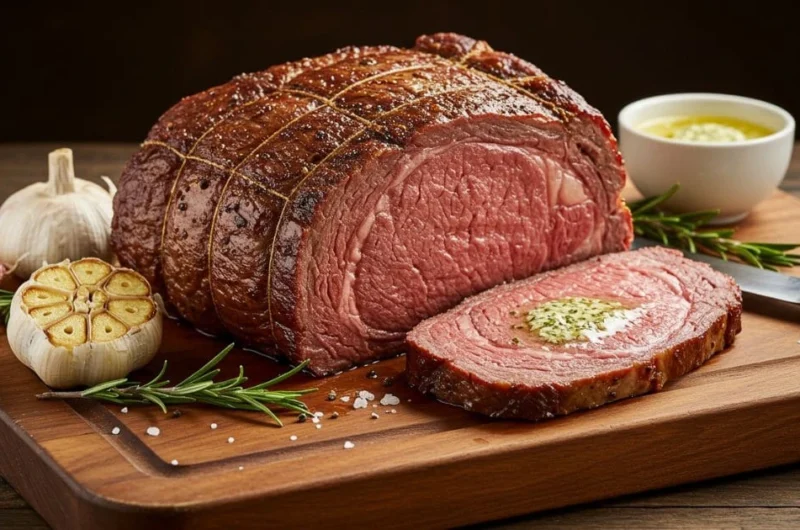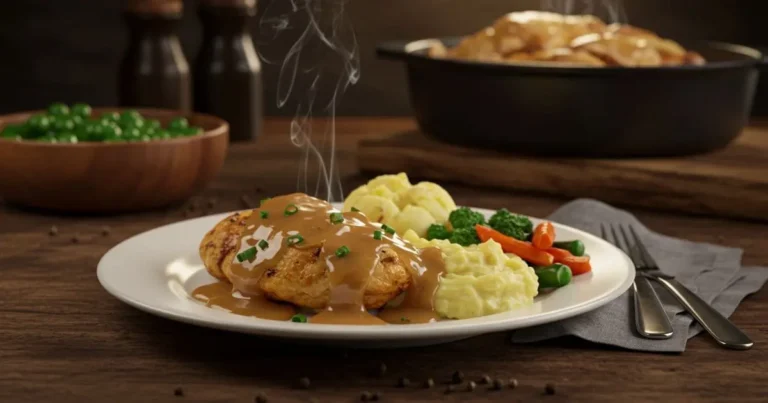Imagine biting into a tender, juicy ribeye roast. It’s filled with rich flavor that makes you crave more. The right recipe, cooking time, and seasoning are key to this amazing taste.
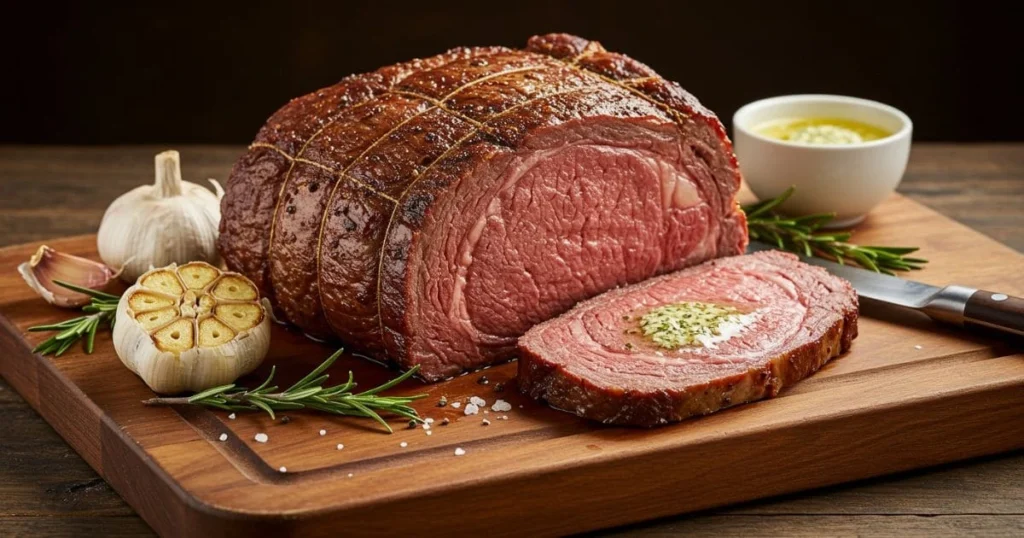
With a few secrets, you can make your ribeye roast stand out. It will impress everyone with its delicious taste. You’ll learn how to cook a ribeye roast perfectly. This article will show you the ultimate recipe, with three secrets for rich flavor, the right cooking time, and the best seasoning.
Table of Contents
Understanding Your Ribeye Roast: A Premium Cut
When cooking a ribeye roast, knowing your meat is key. This cut is tender and full of flavor. To get it just right, think about the meat’s size and how marbled it is. Marbling adds fat, making the meat taste better and feel softer.
A slow-cooked ribeye roast can be amazing. But you must follow a temperature guide to cook it perfectly. The right size and marbling make the meat more tender and juicy. For instance, a bigger cut with more fat will be more tender and juicy.
- Size: A larger cut will result in a more impressive presentation and a more tender final product.
- Fat Distribution: The intricate webbing of fat within the muscle fibers enhances both taste and texture.
- Grade: Choose a high-quality grade of meat for the best results.
By considering these factors and following a reliable ribeye roast temperature guide, you’ll be well on your way to creating a mouthwatering oven-roasted ribeye recipe that’s sure to impress.
Essential Tools and Ingredients for the Perfect Ribeye Roast Recipe
To make a delicious garlic butter ribeye roast, you need the right tools and ingredients. A meat thermometer is key to ensuring the roast is cooked just right. You’ll also need a roasting pan for even cooking. Don’t forget the garlic butter, which adds a rich flavor.
Here are some essential tools and ingredients to get you started:
- Meat thermometer
- Roasting pan
- Garlic butter
- Seasonings and spices (such as salt, pepper, and thyme)
When picking your ribeye roast, choose one with good marbling. This adds flavor and tenderness. With the right tools and ingredients, you’re on your way to a tasty garlic butter ribeye roast. Just remember to watch the cooking time to get it just right.
| Tool/Ingredient | Description |
| Meat Thermometer | Ensures the ribeye roast is cooked to the perfect temperature |
| Roasting Pan | Necessary for even cooking and browning of the ribeye roast |
| Garlic Butter | Adds a rich and savory flavor to the ribeye roast |
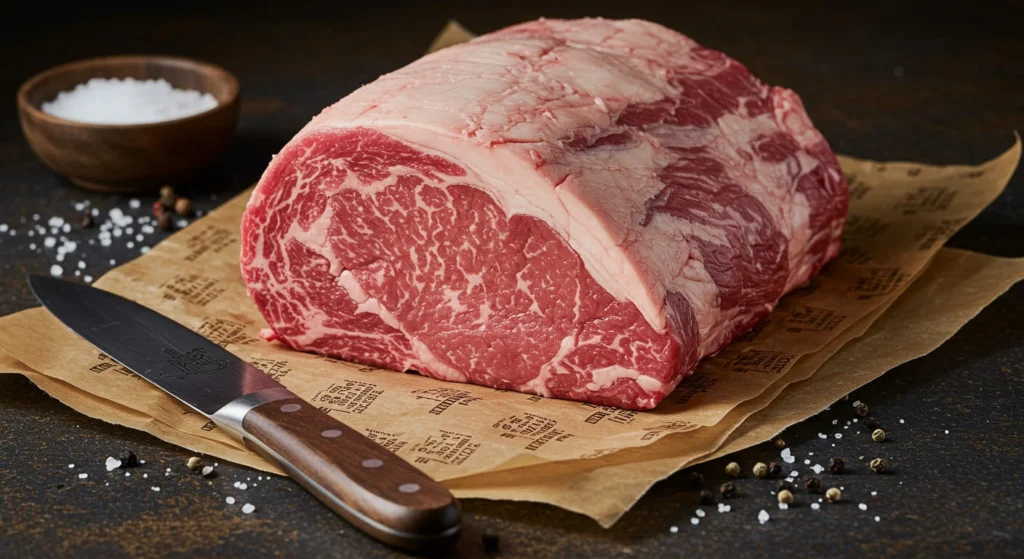
Secret One: The Art of Temperature Control
To get a perfectly cooked ribeye roast, you need to master temperature control.Begin by allowing the roast to rest at ambient temperature for 30-60 minutes before cooking to ensure even heat distribution.Then, cook it at the right temperature and check it with a meat thermometer. This way, you’ll end up with a tender and tasty roast.
Before you start cooking, let the ribeye roast sit at room temperature for 30 minutes to an hour. This makes it easier to cook evenly. For an oven-roasted ribeye, preheat your oven to 200°F to 250°F.
Optimal Cooking Temperatures
The best internal temperature for a ribeye roast is between 130°F and 135°F for medium-rare. For medium, it’s 140°F to 145°F.Monitor doneness precisely by inserting a temperature probe into the roast’s thickest section.
Using a Meat Thermometer Correctly
Put the meat thermometer into the thickest part of the roast, away from fat or bone. This will give you an accurate reading. By following these tips, you’ll get a perfectly cooked ribeye roast that will wow everyone.
| Doneness | Internal Temperature |
| Medium-rare | 130°F – 135°F |
| Medium | 140°F – 145°F |
Secret Two: Mastering the Seasoning Process
Cooking the perfect ribeye roast starts with mastering seasoning. You want to enhance the meat’s natural flavors without overpowering them. To do this, create a great dry rub and consider using garlic butter.
A dry rub is a mix of spices and seasonings applied before cooking. It combines salt, pepper, and other spices to add flavor. For a garlic butter ribeye, add minced garlic to the rub for extra taste.
Creating the Perfect Dry Rub
To make the best seasoning for ribeye roast, balance your dry rub’s flavors. Here are key ingredients:
- Salt and pepper
- Paprika
- Garlic powder
- Onion powder
- Other spices and herbs of your choice
Garlic Butter Enhancement Technique
For richer flavor, try a garlic butter enhancement.Combine room-temperature butter with freshly crushed garlic and aromatic herbs, allowing the mixture to infuse for 10 minutes before application. Then, apply it to the roast during the last few minutes of cooking. This adds a savory taste to your garlic butter ribeye roast.
Timing Your Seasoning Application
Timing is key when seasoning your ribeye roast. Apply the dry rub and garlic butter at the right moment. This ensures flavors penetrate the meat evenly. Experiment to find the best timing for your seasoning.
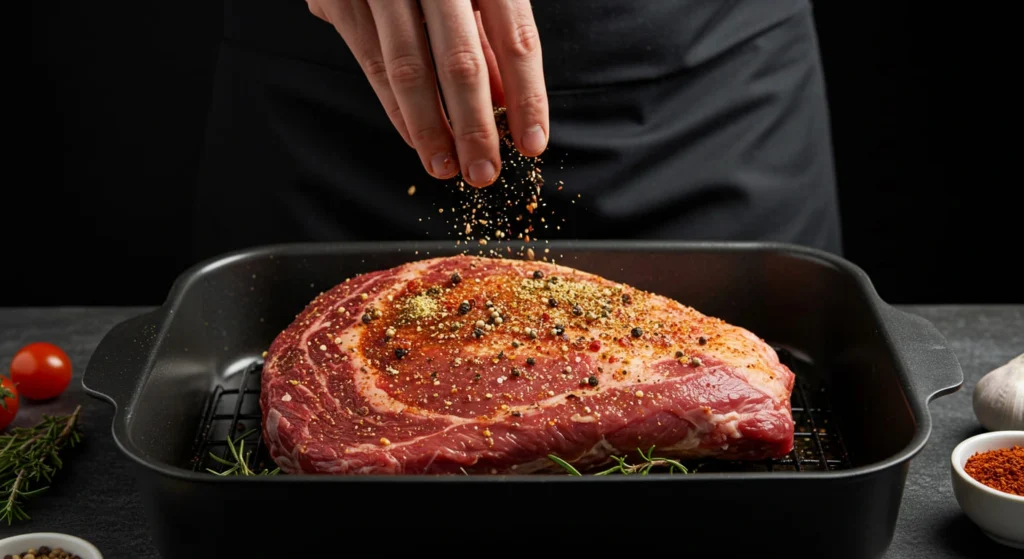
Secret Three: The Perfect Cooking Method
To get a tender and flavorful roast, you need the right cooking method. Slow-cooking the meat over low heat is key. It ensures even cooking, making the roast delicious.
Cooking the meat slowly prevents burning on the outside and undercooking on the inside. This method is essential for a perfect ribeye roast.
The secret to a great ribeye roast is cooking it low and slow. This way, the outside gets crispy, and the inside stays juicy. The roast’s size influences how long it takes to cook. Generally, cook it for about 15 minutes per pound.
Here are some tips for a perfect slow-cooked ribeye roast:
- Employ a precision cooking probe to verify core thermal readings match your desired doneness level.
- Allow the roast to undergo a 10-15 minute post-cook resting phase, ensuring internal fluids equilibrate for even succulence in every slice.
- Use a cast-iron skillet or Dutch oven to cook the roast, as these retain heat well and can help to create a crispy crust.
By following these tips and using the perfect cooking method, you can create a delicious and tender slow-cooked ribeye roast. It will definitely impress your loved ones. Just remember to keep an eye on the cooking time to ensure it’s perfect.
| Cooking Method | Cooking Time | Temperature |
| Slow-cooking | 15 minutes per pound | 300-325°F |
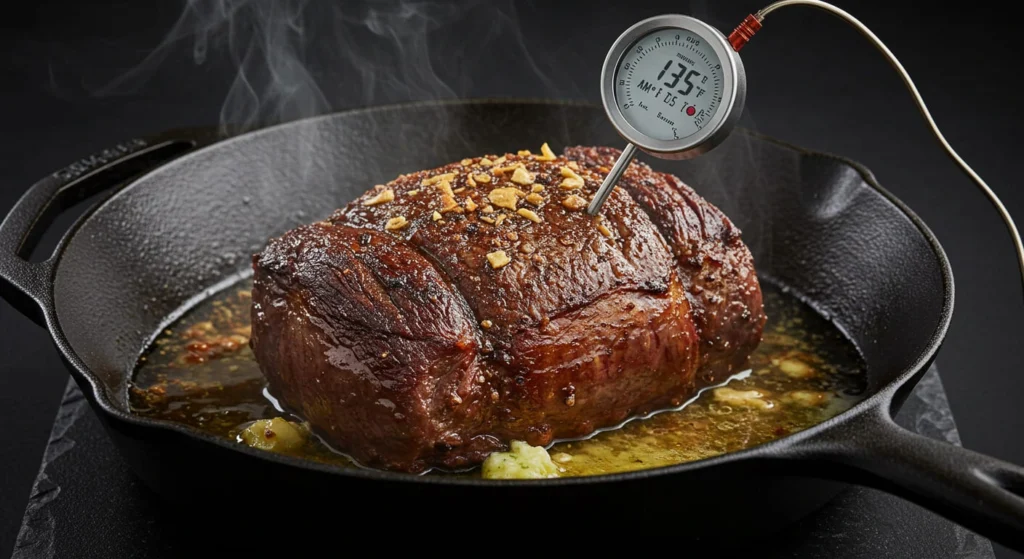
Conclusion:
Creating a delicious ribeye roast recipe is all about mastering three key secrets. These are temperature control, seasoning, and cooking method. By following these, you’ll make a juicy, flavorful roast that will wow everyone.
It’s important to know the right cooking time and seasonings for a perfect ribeye-roast. With a bit of patience and practice, you’ll become a pro at making unforgettable dishes.
Start your journey to becoming a ribeye-roast master. Try new techniques and seasonings. Don’t be afraid to tweak things as you go. The more you practice, the better your roast will taste, and your guests will love it.
FAQs
What is the ideal cooking time for a ribeye-roast?
Cooking time for a ribeye-roast varies based on size and doneness. A 3-4 lb roast cooks in 2-3 hours at 350°F for medium-rare. Always check with a meat thermometer for the right internal temperature.
Which flavor profile works best for enhancing a ribeye-roast?
A dry rub of salt, black pepper, garlic powder, and onion powder is great. Brushing with garlic butter during cooking adds extra flavor.
Is it possible to bake a ribeye-roast?
Yes, oven-roasting is a great way to cook a ribeye-roast. It makes the meat tender and juicy. Just remember to control the temperature and cooking time for the best result.
How do I slow-cook a ribeye-roast?
Slow-cook a ribeye-roast at 275°F for 3-4 hours. This method tenderizes the meat and brings out rich flavors.
What is the ideal internal temperature for a ribeye-roast?
The ideal internal temperature is medium-rare: 130°F to 135°F. – Medium: 140°F to 145°F Use a meat thermometer to check the doneness.
How do I make a garlic butter ribeye roast?
Mix softened butter, minced garlic, salt, and pepper. Spread it on the roast before roasting. The butter melts, basting the meat with savory flavor.
Ultimate Ribeye Roast Recipe: 3 Secrets to Rich Flavor!
Course: LunchCuisine: AmericanDifficulty: Medium4
servings29
minutes2
hours600
kcalDiscover the 3 secrets to an incredibly flavorful ribeye roast with this ultimate recipe.
Ingredients
1 ribeye roast (3-4 lbs)
Salt and black pepper
Paprika
Garlic powder
Onion powder
Fresh garlic (minced)
Butter (softened)
Thyme (optional)
Roasting pan
Meat thermometer
Step By Step
- Prepare the Roast
Let the ribeye roast sit at room temperature for 30-60 minutes before cooking.
Preheat the oven to 200-250°F for slow-cooking or 350°F for faster cooking. - Season the Roast
Mix salt, black pepper, paprika, garlic powder, and onion powder to create a dry rub.
Rub the seasoning mix evenly over the roast. - Apply Garlic Butter
Combine softened butter with minced garlic and thyme.
Let it sit for 10 minutes to allow the flavors to infuse.
Apply this garlic butter to the roast before roasting and again in the last few minutes of cooking. - Cooking the Ribeye Roast
Place the roast in a roasting pan and cook using the low and slow method:
300-325°F for 15 minutes per pound
Or 350°F for 2-3 hours (for a 3-4 lb roast)
Use a meat thermometer to monitor internal temperature:
130-135°F for medium-rare
140-145°F for medium - Resting the Roast
Once done, remove the roast from the oven and let it rest for 10-15 minutes before slicing.
Recipe Video
Notes
- Slow-cooking ensures tenderness and a crispy crust.
- Use a cast-iron skillet or Dutch oven for better heat retention.
- Always rest the meat before slicing to retain juices.
Rate the Recipe
There are no reviews yet. Be the first one to write one.


